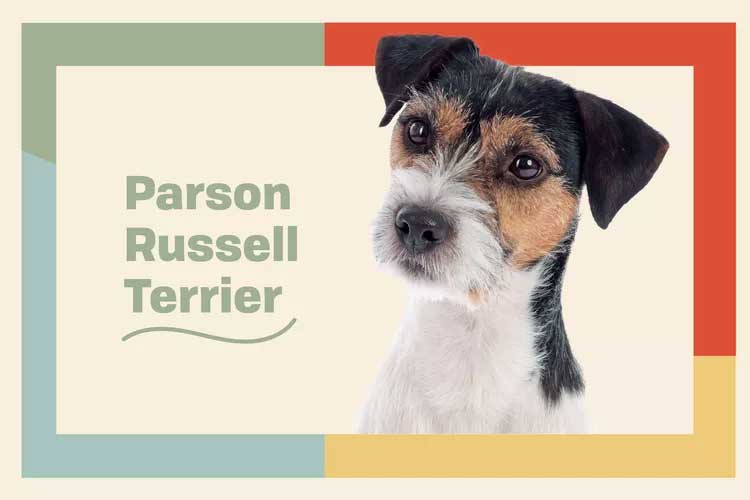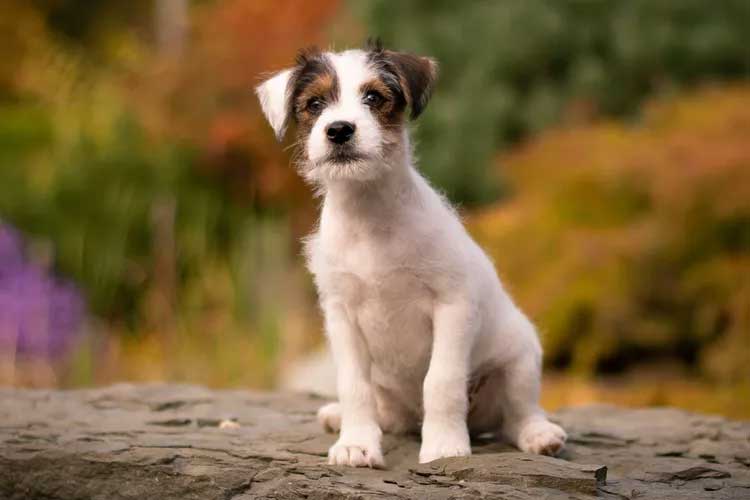Parson Russell terriers are active, intelligent dogs with a long history as fearless fox hunters. The breed makes an excellent companion for experienced dog owners willing to provide lots of training and exercise.

Parson Russell Terrier Overview
| OFFICIAL NAME | Parson Russell Terrier |
| COMMON NAME | Parson Russell Terrier |
| PET HEIGHT | 13 to 14 inches |
| PET WEIGHT | 13 to 17 pounds |
| LIFESPAN | 13 to 15 years |
| GOOD WITH | families |
| TEMPERAMENT | friendly, outgoing, playful, willful |
| INTELLIGENCE | high |
| SHEDDING AMOUNT | infrequent |
| EXERCISE NEEDS | high |
| ENERGY LEVEL | active |
| VOCAL LEVEL | when necessary |
| DROOL AMOUNT | low |
| BREED GROUP | terrier |
| BREED SIZE | small (0-25 lbs.) |
| COAT LENGTH | short, wiry |
| COLORS | black, brown / chocolate / liver, white |
| PATTERNS | bicolor, tricolor |
| OTHER TRAITS | good hiking companion, high potential for weight gain, high prey drive |
You know those petite pooches that think they're a big deal? That's the Parson Russell terrier.
Parsons may be small in stature—they only reach 14 inches tall and weigh less than 17 pounds—but everything else about the breed is oversized. These dogs have big energy, high intelligence, a strong prey drive, and bold personalities.
"It's not an impossible breed, but they need guidance," says Denise Tschida, public outreach chair for the Parson Russell Terrier Association of America.
Tschida says Parsons are a great breed for experienced owners who love the companionship—and challenge—of sharing their lives with active, energetic dogs. But those with a "Netflix and chill" lifestyle who don't want to add "dog training session" and "long run" to their daily to-do lists should steer clear of the Parson Russell terrier.
Appearance
The Parson Russell terrier is a small dog, measuring 13–14 inches tall and weighing between 13–17 pounds. Their short coats come in two textures: broken and smooth.
Smooth-coated Parson Russell terriers, as their name suggests, have short, smooth coats while dogs with a broken coat have a smooth undercoat with longer, wiry—but never wooly or curly—hair. Both smooth and wire-haired Parson Russell terriers have double coats with dense undercoats. They're a low-shedding breed and their coats need minimal grooming.
Their coats are either white, white with black or tan markings, or tricolor (white, black, and tan).
Temperament
Parson Russell terriers are clever, outgoing, active, athletic, independent, and energetic pups with an always-on-the-go attitude. As Tschida says, "they are tenacious and will test your patience."With the right amount of exercise, mental stimulation, and training, Parsons are affectionate, playful dogs that love showing off new tricks and being the center of attention. In fact, Tschida describes Parson Russell terriers as dogs that will "work the room" to get a treat—and with their charming personalities and good looks, they are very likely to have every stranger offering them biscuits.
He's a great breed for experienced dog owners who are willing to go the extra mile with training and exercise in exchange for a spirited companion who is always up for adventure. After a long hike or brisk run, a Parson Russell terrier will be up for some serious snuggling. Just never expect to hit the trails alone; the breed resists spending too much time cooped up and Tschida says unexercised Parsons can be loud and turn to undesirable behaviors (like chewing up your couch cushions) when they are bored.
"Sitting idle is the worst thing for a Parson," she says.
Living Needs
Whether Parson Russell terriers live in a sprawling house or a studio apartment isn't important as long as they get lots of exercise. Parsons are a high-energy breed that wants to go, go, go, whether it's hiking, jogging, endless games of fetch or tug-of-war, or more formal activities like agility, obedience, rally, and tracking.Parsons can be picky about their friends. Although they are known for being playful, affectionate, and outgoing with their owners, the breed can be a little wary of strangers. Socializing a Parson Russell terrier puppy early in life, and consistently as he ages, is vital for helping him learn new people aren't scary.
Thanks to their long history as hunting dogs, their prey drive is high—so hanging out at the park or bringing an adult Parson into a home with small animals might not be the best idea. In fact, Parson Russell terriers may be best as solo pets or require a slow introduction to new family members.
Whether solo pets or part of a pack, all Parson Russell terriers expect the same thing: lots of attention from their owners, plenty of exercise, and lots of mental stimulation. Don't put a Parson Russell terrier out in the yard and expect him to entertain himself; they will find ways to dig under the fence or even climb over it—for small dogs, they have a great vertical leap! It's also important to keep Parsons on a leash in unsecured areas to prevent them from chasing a scent or darting off after a neighborhood rabbit.
Care
When you share a home with a Parson Russell terrier, be prepared to devote a lot of attention to keeping him healthy and happy. In addition to plenty of regular exercise, training is essential."They will do anything you ask of them, as long as you ask enough and ask the right way," Tschida says.

In other words, because of their strong prey drive and background as hunting dogs, Parson Russell terriers can find themselves absorbed in the world around them, resulting in the inability to both process and respond to your cues while they are so distracted. You'll need to woo them with consistent praise and positive reinforcement. These are highly intelligent dogs who can easily master cues but may choose to do their own thing. Patience and consistency are key!
Keeping sessions fast-paced, short, and interesting can help Parson Russell terriers remain engaged in their training. Outside of regular training sessions, puzzle feeders, interactive toys, and games can provide the mental stimulation that Parsons need to thrive.
Although Parson Russell terriers require a lot of exercise, training, and mental stimulation, they require minimal grooming (leaving more time for running, jumping, sniffing, and chasing!). A quick bath, regular brushing to remove dead hair as well as nail trims, ear cleanings, and routine dental care (both through professional cleaning appointments and at-home brushing) are all Parsons need to look and feel their best.
Health
Parson Russell terriers are considered a healthy breed with long lifespans ranging from 13–15 years. But it's still a good idea to be on the lookout for a few common health issues the breed is susceptible to, according to the breed club.Like other small breeds, Parson Russell Terriers are at greater risk for a luxating patella. The condition causes loose kneecaps and is diagnosed when the kneecap (patella) moves out of its normal location. A luxating patella can be painful and may make it difficult for dogs to put weight on the affected leg. Surgery may be recommended for severe or chronic cases.
Parsons can also be diagnosed with spinocerebellar ataxia. This progressive neurodegenerative disease results when the cerebellum, the part of the brain responsible for movement, is underdeveloped. It's a genetic condition that causes lack of coordination, loss of balance, and spastic movements. The symptoms normally appear between two and six months of age, but there is a "late onset" version of the disease that may not show up until Parson Russell terriers are older. It can be detected via a DNA test, and unfortunately there is no cure.
Parson Russell Terriers, like other dogs with white coats, have a pigmentation gene that has been linked to deafness. The condition can be genetic, but certain illnesses, including intrauterine infections, liver disease, and exposure to toxins can also cause congenital deafness. The first symptoms, which include ignoring squeaky toys and verbal cues, abnormal vocalizations, disorientation, and lack of reaction to loud noises, often appear within a few weeks after the dog is born. While there is no cure for congenital deafness, deaf Parson Russell terriers can live long, happy lives and are quick to pick up hand signals during training.
History
English Reverend John Russell, known as "the sporting parson," is credited with developing the breed. Russell had a passion for hunting and raised a pack of hound dogs, including a terrier from Oxford, that he acquired in 1818.

Russell bred the dogs to be tenacious, energetic fox hunters with thick, wiry double coats that protected them from wet and cold weather. The dogs relied on their intelligence and problem-solving skills to hunt red fox both over and underground, often working alongside royals in pursuit of their quarry.
When Russell died, the dogs continued to be developed and eventually split into two different breeds: Russell terriers and Parson Russell terriers. And while both breeds look nearly identical, they differ in size. Russell terriers only stand 12 inches tall and weigh up to 15 pounds. Parsons are slightly bigger, at 14 inches tall and 17 pounds.
Fun Facts
The AKC recognized the Parson Russell terrier as an official breed in 1997. The dogs' closely related cousins, Russell terriers, were recognized in 2012.In 2017, a Parson Russell terrier named Smurf performed 32 tricks in one minute, earning a spot in the Guinness Book of World Records (and proving that the breed is smart and fast!).